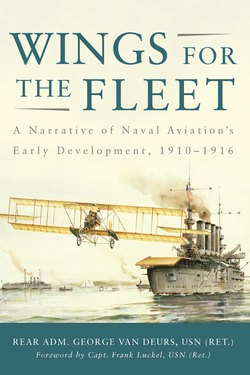Читать книгу Wings for the Fleet - George Van Deurs - Страница 6
На сайте Литреса книга снята с продажи.
ОглавлениеPREFACE
The span of but half a century separates the first flight of an aeroplane off the deck of a naval vessel from the first ascent of a naval aviator into outer space. The early days of this extraordinary development seem now to have been of another age and era. Yet it is a fact that within the lifetime of many, man has moved from the achievement of successful heavier-than-air flights to the penetration of space beyond the limits of the atmosphere of the earth on which he lives. And today no man can foretell the limit of this progression.
In the United States Navy the first phase of this development came to an end with the entry of the United States into the first World War in 1917. It had commenced in 1910, a full seven years after the then hardly noticed and the now memorable flights of the Wright brothers at Kitty Hawk. During the ensuing seven years the airplane was either the hobby of some rich sportsman or the stock-in-trade of the daredevil flier, who eked out a hazardous living by exhibition flights at the primitive air meets of that day. The development of aircraft and of flying in the Navy was inevitably tinctured by the glamour of that early time.
The officers who pioneered in naval aviation were few in number. They were venture-some individuals, who became pilots by their own choice. They worked against great odds. It was their destiny to develop aviation into an effective arm of the Fleet. This development was more a matter of faith than anything else. Its contemporary performance was so strange and unique as to be hardly credible to conservative naval officers. The elder of these officers, exercising the great power of seniority, had trained in sail and had only recently accepted the steam engine. Those who sought to become naval fliers had much to overcome in the way of inertia, professional conservatism, and closed minds.
The miracle is that some of these pilots, having survived the hazards of early flying and of two world wars in which they were the pre-eminent leaders of naval aviation, have lived on into the day when their successors are seeking to blaze a trail into space.
Among those who have made generous contributions of their time and knowledge to the making of this book in the form of both letters and personal interviews are Vice Admiral P. N. L. Bellinger, U.S. Navy (Retired), deceased; Mrs. Eugene Ely, deceased; Colonel F. T. Evans, U.S. Marine Corps (Retired); Admiral A. W. Fitch, U.S. Navy (Retired); Mr. Paul Garber, National Air Museum, Washington, D.C.; Mr. George C. Gilmore, Pensacola, Florida; Captain F. A. LaRoche, U.S. Navy (Retired); Mr. M. W. McFarland, Library of Congress; Rear Admiral L. N. McNair, U.S. Navy (Retired), deceased; Captain Charles H. Maddox, U.S. Navy (Retired); Admiral George D. Murray, U.S. Navy (Retired), deceased; Fleet Admiral Chester Nimitz, U.S. Navy, deceased; Mrs. Edna Whiting Nisewaner; Mr. Lee M. Pearson, Historian, Naval Air Systems Command, Department of the Navy, Washington, D.C.; Admiral A. M. Pride, U.S. Navy (Retired); Captain Braxton Rhodes, U.S. Navy (Retired), deceased; Mr. M. C. Sloan, Air Force Museum, Wright-Patterson Air Force Base, Ohio; Lieutenant Colonel Edna L. Smith, U.S. Marine Corps Women’s Reserve (Retired); Mrs. J. H. Towers; Mr. A. O. Van Wyen, Head of Aviation History Unit, Office of Chief of Naval Operations, Department of the Navy, Washington, D.C.; Mr. Alfred V. Verville, pioneer aviation designer; Mr. Charles L. Wiggin, pioneer aviation mechanic; and last but not least, many patient librarians.
My special thanks are due Mr. Dudley C. Lunt, who himself served in the Navy in World War I, and who did most of the final editing.
To all those named, and to those helpers I have been unable to name, my thanks.
Rear Admiral
U.S. Navy (Retired)
Belvedere, California
1 February 1966
